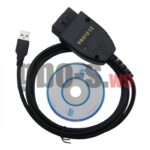Replacing an exhaust gas temperature (EGT) sensor can be a challenging task, especially when located in a difficult-to-access area. This article addresses common issues encountered when dealing with EGT sensor replacement, specifically focusing on the Vcds P0544 fault code, which indicates a problem with the Exhaust Gas Temperature Sensor Circuit Bank 1 Sensor 1. We’ll delve into diagnostics, troubleshooting, and solutions, drawing on a real-world example using VCDS diagnostic software.
Diagnosing the P0544 Fault Code with VCDS
The original poster describes difficulty accessing and replacing the EGT sensor. They’ve used a multimeter to check the sensor, logged data while driving, and even temporarily connected a new sensor. While the new sensor seemingly cleared the P0544 code, it triggered a Diesel Particulate Filter (DPF) light. The poster is also struggling to access data in Measuring Block 106 using VCDS. Let’s break down these issues:
Accessing Measuring Block 106 Data
The inability to view values in Measuring Block 106 suggests a potential communication issue or incorrect measuring block selection. Ensure you’re in the correct engine controller module and using the correct block number for your specific vehicle model. Consulting the official Ross-Tech VCDS website or reputable online forums for your car model can provide the necessary information. A factory repair manual can also offer guidance.
The Relationship Between EGT Sensor and DPF
The DPF light illuminating after connecting the new EGT sensor could indicate several things. It might be a coincidence, a faulty new sensor, or a related issue triggered by the sensor replacement. Since the previous logs showed intermittent readings from the old sensor, the DPF might have accumulated soot due to improper regeneration cycles. The DPF light could also be due to an incorrect adaptation process after replacing the sensor.
Interpreting VCDS Logs
The provided VCDS logs offer valuable insights:
- Initial Log (Bad Sensor): Shows engine speed, temperatures before and after the DPF, oil ash volume, specified and actual carbon mass, and calculated/measured soot load. The intermittent readings from the faulty EGT sensor likely contributed to inaccurate soot load calculations.
- Second Log (New Sensor, DPF Light): This log, taken after clearing codes and connecting the new sensor, interestingly shows no fault codes in the engine module. However, fault codes are present in other modules (Central Electrics and Navigation), which are likely unrelated to the P0544 issue. The absence of the P0544 code suggests the new sensor might be functioning correctly, but the DPF light requires further investigation.
Troubleshooting VCDS P0544
Addressing the VCDS P0544 and the subsequent DPF light requires a systematic approach:
- Verify Sensor Installation: Double-check the new sensor’s connection and wiring for any damage or loose connections.
- Clear DTCs and Perform Adaptation: After installing the new sensor, clear all DTCs using VCDS. Certain vehicles require specific adaptation procedures for the new EGT sensor to function correctly. Consult your vehicle’s repair manual for these procedures.
- DPF Regeneration: Given the DPF light, a forced DPF regeneration might be necessary. This can often be initiated through VCDS. Again, refer to your vehicle’s specific instructions within the repair manual or on reputable online resources.
- Further Diagnostics: If the DPF light persists, use VCDS to check for DPF-related fault codes. This will pinpoint the cause of the DPF issue, which might be independent of the EGT sensor replacement.
Conclusion
The VCDS P0544 fault code signifies a problem within the EGT sensor circuit. While replacing the sensor is a common solution, it’s crucial to ensure correct installation, perform necessary adaptations, and address any related issues like DPF regeneration. Utilizing VCDS effectively, along with referencing reliable resources like factory repair manuals, allows for accurate diagnosis and targeted troubleshooting, leading to a successful repair. Using a systematic approach and carefully analyzing VCDS data is essential for resolving this issue and ensuring optimal vehicle performance.

